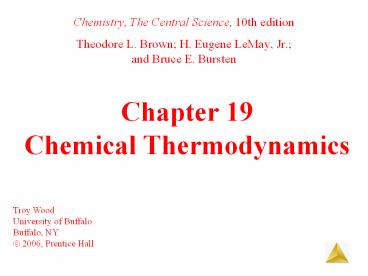Chemistry, The Central Science, 10th edition PowerPoint PPT Presentation
1 / 21
Title: Chemistry, The Central Science, 10th edition
1
Chapter 19Chemical Thermodynamics
- Chemistry, The Central Science, 10th edition
- Theodore L. Brown H. Eugene LeMay, Jr.
- and Bruce E. Bursten
Troy Wood University of Buffalo Buffalo, NY ?
2006, Prentice Hall
2
Melting a cube of water ice at ?10C and
atmospheric pressure is a ________ process.
- Spontaneous
- Nonspontaneous
3
Correct Answer
Melting of an ice cube at 1 atm pressure will
only be spontaneous above the freezing point
(0C).
- Spontaneous
- Nonspontaneous
4
The sign of entropy change, DS, associated with
the boiling of water is _______.
- Positive
- Negative
- Zero
5
Correct Answer
- Positive
- Negative
- Zero
Vaporization of a liquid to a gas leads to a
large increase in volume and hence entropy DS
must be positive.
6
- Decomposition of CaCO3 has a ?H 178.3 kJ/mol
and ?S 159 J/mol ? K. At what temperature
does this become spontaneous?
- 121C
- 395C
- 848C
- 1121C
7
Correct Answer
- 121C
- 395C
- 848C
- 1121C
T ?H/?S T 178.3 kJ/mol/0.159 kJ/mol ? K T
1121 K T (C) 1121 273 848
8
Which of the following would be expected to have
the highest entropy?
- 1 mole N2(l)
- 1 mole N2(g)
- 1 mole Ar(g)
- 1 mole Ar(s)
9
Correct Answer
- 1 mole N2(l)
- 1 mole N2(g)
- 1 mole Ar(g)
- 1 mole Ar(s)
Given the same amounts, gases have higher entropy
than liquids, which have higher entropy than
solids. Of the gases, N2 has greater entropy
than Ar because N2 is a molecule that can store
energy in ways not possible for Ar.
10
Calculate DS for the equation below using the
standard entropy data given 2 NO(g) O2(g) ? 2
NO2(g) DS values (J/mol-K) NO2(g) 240, NO(g)
211, O2(g) 205.
- ?47 J/mol
- ?76 J/mol
- 176 J/mol
- 147 J/mol
11
Correct Answer
- ?147 J/mol
- ?76 J/mol
- 176 J/mol
- 147 J/mol
(
)
(
)
?
?
?
?
D
?
D
?
D
reactants
products
S
S
S
DS 2(240) ? 2(211) 205 DS 480 ? 627
DS ? 147
12
Predict whether entropy increases, decreases, or
stays constant for 2 NO2(g) ? 2 NO(g)
O2(g)
- Increases
- Decreases
- Stays constant
13
Correct Answer
- Increases
- Decreases
- Stays constant
The entropy increases because two molecules of
gas react to form three molecules of gas, leading
to more disorder.
14
Calculate DG for the equation below using the
Gibbs free energy data given 2 SO2(g) O2(g) ?
2 SO3(g) DG values (kJ) SO2(g) ?300.4, SO3(g)
?370.4
- 70 kJ
- 140 kJ
- ?140 kJ
- ?70 kJ
15
Correct Answer
- 70 kJ
- 140 kJ
- ?140 kJ
- ?70 kJ
(
)
(
)
?
??
?
?
?
reactants
products
G
G
G
?
f
f
DG (2 ? ?370.4) ? (2 ? ?300.4) 0 DG
?740.8 ? ?600.8 ?140
16
Calculate DG for the equation below using the
thermodynamic data given N2(g) 3 H2(g) ? 2
NH3(g) DH (NH3) ?46 kJ DS values (J/mol-K)
are NH3 192.5, N2 191.5, H2 130.6.
- ?66 kJ
- ?33 kJ
- 33 kJ
- 66 kJ
17
Correct Answer
- 33 kJ
- 66 kJ
- ?66 kJ
- ?33 kJ
DH ?92 kJ DS ?198.7J/mol ? K DG DH ?
TDS DG (?92) ? (298)(?0.1987) DG (?92)
(59.2) ?33
18
- Both the entropy, DS and the enthalpy DH have
positive values. Near absolute zero (0 K), will
the process be spontaneous or nonspontaneous?
- Spontaneous
- Nonspontaneous
19
Correct Answer
- Spontaneous
- Nonspontaneous
At low temperatures, the enthalpy term dominates
the entropy term, leading to a positive DG and a
nonspontaneous process.
20
Suppose ?G is a large, positive value. What
then will be the value of the equilibrium
constant, K?
- K 0
- K 1
- 0 lt K lt 1
- K gt 1
21
Correct Answer
?G ?RTlnK Thus, large positive values of DG
lead to large negative values of lnK. The value
of K itself, then, is very small, approaching
zero.
- K 0
- K 1
- 0 lt K lt 1
- K gt 1

